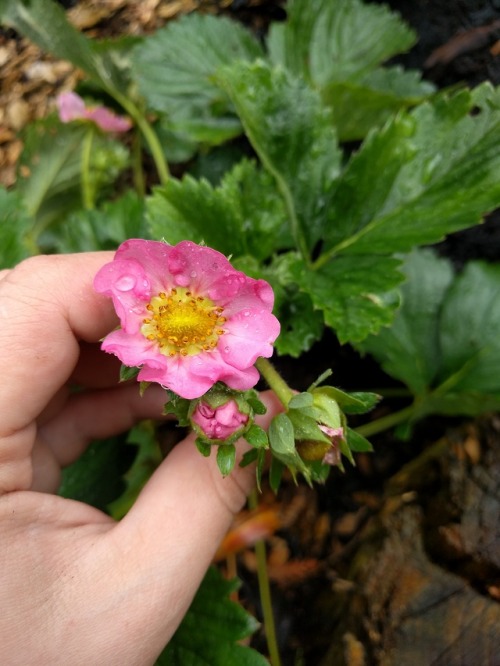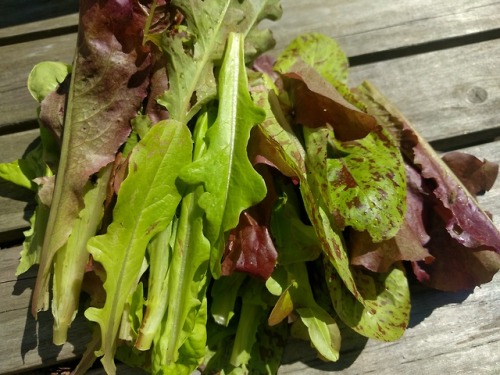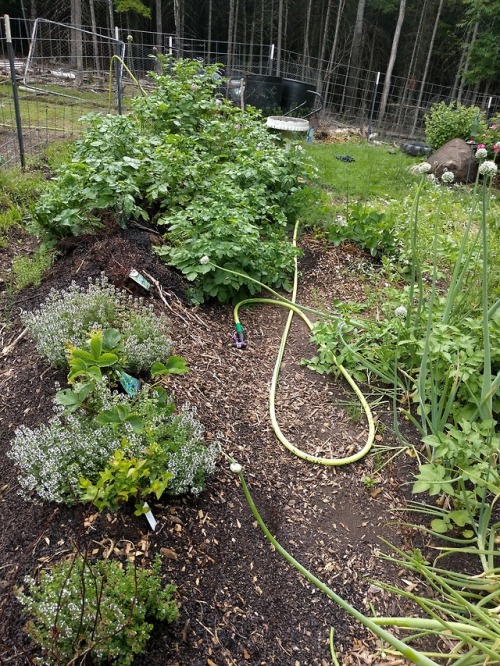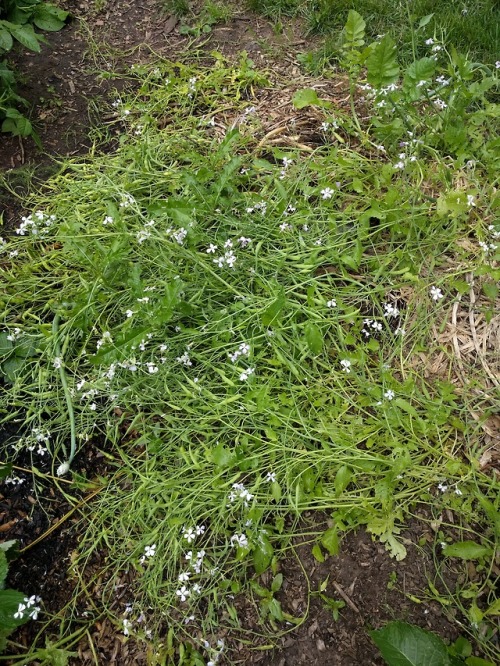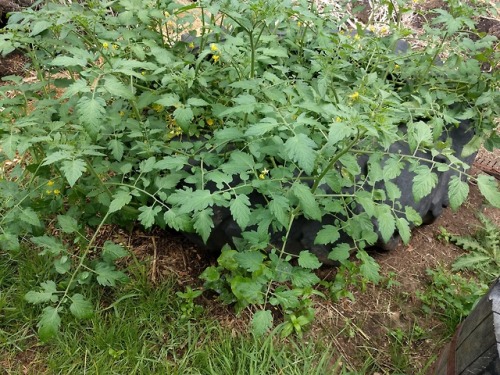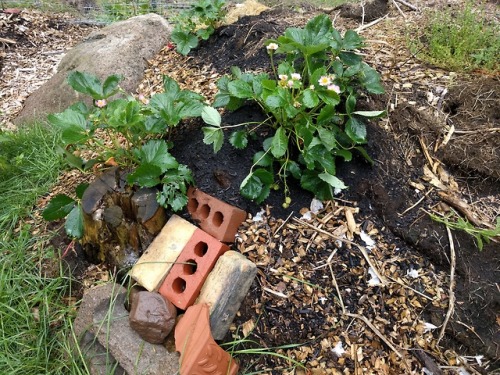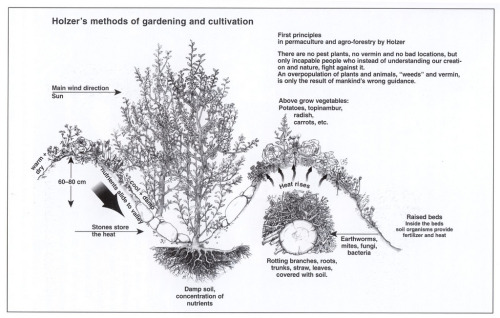#hugelkultur
More scenes from the Big Garden.
I planted a new strawberry last summer, I’m very particular about which and where I plant so I can tell them apart and figure out the best varieties for our conditions after some unproductuve duds. When I found these edible ornamentals with COLOUR FLOWERS I snatched them up, both for the novelty and easy identification! They’re a light and dark pink, specific to each mother plant. One tag said “Toscana”, which there is plenty of info online about but the other was something like “Havana” or “Hovana” but I can’t any information on it. Or even any other shades/names for pink strawberies besides Toscana, so make of that what you will. They are doing great as a garden perennial and also look fantastic cascading out of a hanging basket, which is how I origionally bought them.
I’m also very excited to see my buckweat flowering, although of the three pounds of seeds I planted it was considerably sparse. Rodents have been digging up my seeds just as fast as I plant them, sometimes eliminating entire crops before they can sprout, and it’s become an epidemic in our garden… I’m hoping to fill in gaps around the garden and between beds with Buckwheat to use as bee forage. A local homesteader recommended it for it’s fast growth and ease of uprooting when rotating crops. It also produces a dark molasses-like honey if a lot is available.
July 17, 2017
Post link
Summer garden getting into full swing!
Here’s some hardy roses, greens clipped for lunch, our hugelkultur mounds with perennial berries and herbs, a ground cover of radishes and rye that I pull up and use as green manure (it’s been coming back for a few years, anywhere I drop the seeds), squash vines (on a hugel mound) with a cattle panel set up for a trellis, and tractor tire raised bed full of tomatoes.
Finally, what I’m hoping will be a snake habitat to control pests. It’s set into a hugel mound that the rodents made nests and tunnels in, there’s a water dish nearby and the bricks and rocks catch the sun and warm up. I’ll let the grass around it grow long to create cover. Strawberries grow on top.
July 16/17, 2017
Post link
Hügelkultur (German, meaning “hill culture” or “mound culture”) is the garden concept of building raised beds over decaying wood piles. Decayed timbers become porous and retain moisture while releasing nutrients into the soil that, in turn, promote root growth in plant materials. As the logs decay, they expand and contract, creating air pockets that assist in aerating the soil, allowing roots to easily penetrate the soil. This decaying environment creates a beneficial home to earthworms. As the worms burrow into the soil, they loosen the soil and deposit nutrient-rich worm castings, beneficial to plants. An earthworm can produce its weight in castings on a daily basis.
The best decayed wood for a Hügelkultur, according to A Growing Culture, comes from alders, applewood, cottonwood, poplar, maple and birch. Use wood products that have been in the process of decay for about a year (using green, or fresh, wood products will rob the soil of necessary nitrogen). Some wood products, like cedar and black walnut, should be avoided because they produce organisms that negatively effect plant growth.
Read more at A Growing Culture.
Post link
Permaculture Lessons, part two: Disabled Permaculture
Permaculture Lessons, part two: Disabled Permaculture
This is a guest post by Laura-Marie River Victor Peace Nopales (see contact info below).
Hello! I made a guest post on Awkward Botany in March, introducing myself and my spouse, and talking a little about my life with permaculture. Permaculture is a way I learn about plants, love the earth, grow delicious foods, and connect with others. Permaculture has a community aspect, and respect for all…

Hügelkultur (German, meaning “hill culture” or “mound culture”) is the garden concept of building raised beds over decaying wood piles. Decayed timbers become porous and retain moisture while releasing nutrients into the soil that, in turn, promote root growth in plant materials. As the logs decay, they expand and contract, creating air pockets that assist in aerating the soil, allowing roots to easily penetrate the soil. This decaying environment creates a beneficial home to earthworms. As the worms burrow into the soil, they loosen the soil and deposit nutrient-rich worm castings, beneficial to plants. An earthworm can produce its weight in castings on a daily basis.
The best decayed wood for a Hügelkultur, according to A Growing Culture, comes from alders, applewood, cottonwood, poplar, maple and birch. Use wood products that have been in the process of decay for about a year (using green, or fresh, wood products will rob the soil of necessary nitrogen). Some wood products, like cedar and black walnut, should be avoided because they produce organisms that negatively effect plant growth.
Read more at A Growing Culture.
I made one of these and it was working amazingly well until our meat rabbit (she was a pet we rescued but “meat rabbits” are a particular S I Z E ) broke down the fence around it, ate everything upon it, and declared it her bed forevermore. Attempted fence rebuilds were thwarted by tunnels or straight up flattening of fences. The hügelkultur was left to the triumphant bunny.
10/10 for horticulture but also 10/10 rabbit bed as declared by an actual rabbit.
Post link


